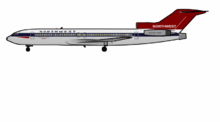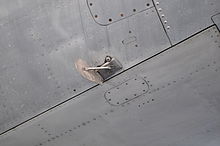- Cooper vane
-
 Diagram showing how D. B. Cooper left the hijacked airplane; now, the Cooper vane makes this impossible.
Diagram showing how D. B. Cooper left the hijacked airplane; now, the Cooper vane makes this impossible.
A Cooper vane (also sometimes called a "Dan Cooper switch" or "D.B. Cooper device") is a mechanical aerodynamic wedge that prevents the ventral airstair of an aircraft from being lowered in flight.[1] Following three hijackings in 1972, the Federal Aviation Administration ordered that Boeing 727 aircraft be fitted with Cooper vanes.[2] The device was named for famed airplane hijacker D. B. Cooper, who used the rear stairway to exit a Boeing 727 in flight and make his escape via parachute.
The Cooper vane is a very simple device consisting of a spring-loaded paddle connected to a plate. When the aircraft is on the ramp, the spring keeps the paddle perpendicular to the fuselage, and the attached plate does not block the stairway. As the aircraft takes off, the airflow pushes the paddle parallel to the fuselage and the plate is moved underneath the stairway, preventing it from being lowered. Once the airflow decreases on landing, the spring-loaded paddle returns to its initial position, thereby allowing the stairs to be lowered again. Although this device was intended to prevent hijackings aboard the 727 and other aircraft with a ventral airstair, many airlines sealed the airstair entirely, never to use it again.
References
- ^ Malcolm Gladwell (October 1, 2001). "Safety in the Skies: How far can airline security go?" (PDF). The New Yorker: pp. 50. http://www.gladwell.com/pdf/safetysky.pdf.
- ^ Bruce Schneier (2003). Beyond Fear: Thinking Sensibly about Security in an Uncertain World. p. 82. ISBN 0387026207. http://books.google.com/books?id=wuNImmQufGsC&dq=%22Cooper+vane%22&cad=0.
Categories:- Aircraft doors
Wikimedia Foundation. 2010.

